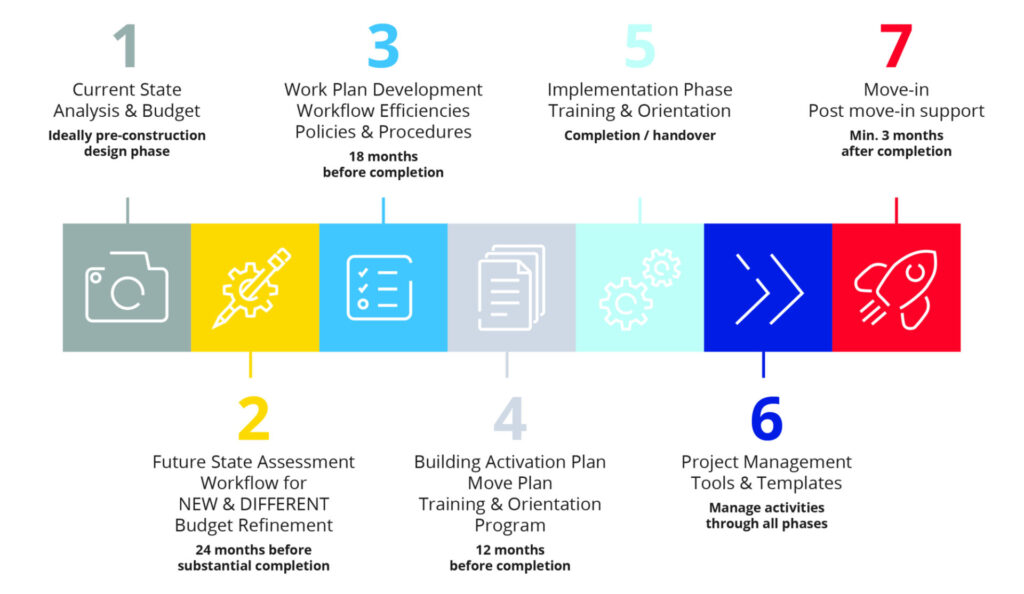Canada’s capital projects involve a multitude of activities, from construction and infrastructure development to equipment planning, organizational change and relocation. Moving into a new or retrofitted space can be exciting, but it often involves so much more than just moving boxes. It requires careful planning and coordination of multiple moving parts, including people, equipment and technology.
The complexities of move management and operational readiness are often overlooked. We place so much emphasis on construction schedules and budgets, we sometimes forget that moving into a new and unfamiliar space can also carry risk. It takes forward-thinking, multi-faceted coordination and time to successfully transition – and that is why operational readiness is critical to move management.
What is operational readiness?
Operational readiness is the state at which an organization’s people, procedures and systems are fully prepared to effectively support change as a result of a move or redevelopment project. It’s a service that puts your people first – from employees to project stakeholders, clients and the communities you serve.
Operational readiness involves an incremental series of actions that enable an organization’s transformation as its people relocate, resume operations and discover a new space. These seven essential steps include:
- Analyzing your current state and budget
- Conducting a future state assessment workflow for new or different budget refinement
- Developing a work plan and identifying workflow efficiencies, policies and procedures
- Building an activation plan, move plan, and training and orientation program for your new space
- Implementing your training and orientation program
- Identifying project management tools and templates to help you manage these activities
- Moving into your new space with the assurance of having ongoing transitional support

The overall goal of operational readiness is to build confidence so your organization can successfully transition and operationalize with as little service disruption as possible. In some scenarios, closing for a day is a possibility, while in others, there’s a need to ramp-down operations in one location while you transition and slowly ramp-up operations in the new location. The more complex or critical your service offering, the more important it is to incorporate operational readiness into your project plan.
Transitioning with confidence
Operational readiness can benefit a variety of project types, from hospital and labs, to colleges, universities, libraries, judicial services, corporate offices, community centres, retailers and more.
When you invest in a capital project, you’re investing in the development of a new space. When you invest in operational readiness and move management, you’re investing in a sustainable future for your organization, people, operations and clients. It’s a process that enables your staff to transition into a new space with the confidence to perform their roles and serve clients across all phases of the project.
Moves can be frustrating, but as you layer on complexities including the size of the facility, multiple phases, timelines driven by construction schedules, distance to the new location and the need to provide continuous service, your move has more of an impact on your staff and the community you serve. Healthcare projects, for example, can be some of the most critical to manage because they can impact patient services directly, and also carry more risk. In addition, healthcare facilities often require specialized equipment, as well as higher levels of security to ensure all documents and patient files remain confidential during the move.
Hospitals need to provide reliable and continuous care throughout all stages of a capital project – especially when it comes to its emergency, ICU and acute care capabilities. You can’t easily shut down a hospital’s emergency room (ER) for a day or expect staff to walk into a turnkey space and take on emergency patients without knowing where things are or having the assurance that equipment has been tested to ensure a smooth transition.
Additionally, you can’t change the location of an ER without communicating the transition to other hospitals, paramedic teams, the community, patients, and staff. Communication is an essential piece of operational readiness, as it provides:
- a well-defined and organized space that enables you to seamlessly transition operations without increasing wait times or losing revenue;
- a customized, comprehensive plan to ensure relocated personnel are trained, orientated and functional on day one;
- assurance that all equipment and furniture are trialed, tested and ready;
- consideration of externally impacted groups such as clients and community members; and
- confidence that your physical relocation supports successful and sustainable operations.
A big picture view
So, why is operational readiness critical to move management? The answer is multifaceted. There are several benefits to combining physical moves with operational readiness plans.
Operational readiness takes a step back from capital project planning and moving boxes to look at the bigger picture. By examining how your facility operates at an existing location, project managers can help ensure you’re fully prepared to resume or ramp-up operations in a new space, and that you and your team are ready to deliver seamless, consistent, quality services.
By combining operational readiness and move management, you’re investing in the people that drive your organization. Operational readiness offers you a comprehensive plan and the benefit of looking ahead and thinking things through beyond construction. It rounds out your project services and enables your organization to approach move management with confidence, and with the knowledge that you’re prepared to tackle any challenges that may arise.
Funding support for operational readiness is also readily available. In Ontario, the Ministry of Health recognizes operational readiness and transition planning as a critical component of a capital project. But support can be found across Canada, work with your finance and project management teams to see what resources are available to you. Don’t let funding be a barrier to your project’s success, discuss operational readiness and transition costs as part of your next capital budget.
Interested in learning more about the benefits of operational readiness? Email info@colliersprojectleaders.com to connect with one of our experts.






